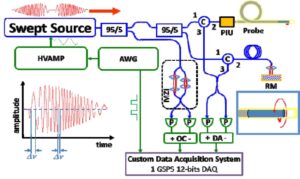
Many advances have been made in the field of science and technology which have made a huge impact on how the world functions. One such advancement is the development of swept source, which has revolutionized the field of medical ophthalmology. They were introduced in 2012 for optical coherence tomography (OCT) which has helped ophthalmologists all over the world to help diagnose and treat optical problems like glaucoma with relative ease. Swept source offers deep penetration, high resolution, faster acquisition time and long coherence length, thus making it the ideal light source for OCT.

A type of laser, the development of swept source has been connected with OCT. Their unique abilities make it easier to visualize retinal structures like choroid and vitreous despite the presence of pre-retinal hemorrhages. The use of swept source optical coherence tomography (SS-OCT) has made immense contributions to the field of ophthalmology, especially vitreous body. This technology (SS-OCT) has been a revolutionary one as it has contributed vastly in demonstrating the entire structure of posterior pre-cortical vitreous pocket (PPVP) in vivo.
With the advent of SS-OCT, the search for a laser that could achieve a desired 1003performance, representing a 100nm wavelength sweep range at 100 kHz repetition rate and with 100 pm line width, was complete. So, essentially swept source can be considered a type of tunable laser with important applications in the field of ophthalmology.
There are numerous applications of the SS-OCT system. The higher penetration intensity observed has made it easier to view the choroid. It plays a crucial role in central serous chorioretinopathy and uveitis. It helps in providing high transverse resolution, not possible with other sources, which is essential for scanning and obtaining a proper image of the retina.
An ultrahigh-speed endoscopic SS-OCT system was developed for clinical gastroenterology which proved quite helpful as good sample coverage was possible with the high quality of the image. Different functional OCT imaging techniques have been developed to provide additional image contrast on top of OCT structural images. In OCT angiography, multiple scans are taken from the same position to help visualize blood flow in contrast to the fixed remaining samples. Additionally, it can be used to determine tissue elasticity too.
SS-OCT can also be used in glaucoma detection, risk factor identification and understanding of the disease mechanism.
Inphenix is a US-based laser diode and light source manufacturer specializing in manufacturing photonics devices such as Semiconductor Optical Amplifiers (SOA), Superluminescent Diodes (SLDs), Gain Chip, Lidar Lasers, and many others. The firm also builds customized laser devices based on the clients’ needs.
